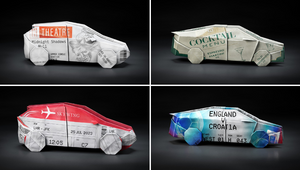
The Endless Universes of Unreal: Location Shoots Made Easy

As authorised partners for Unreal Engine, in this interview, Taylor James dive into the exciting potential of the ever-evolving game engine and what it means for the future of location shoots with lead CGI/real time artist Dave Sturch, creative director Dave Cox and executive producer Frederik Soares.
LBB> Unreal has been around for a while but how has it evolved in recent years?
Dave S> Unreal has evolved insanely fast in recent years, and the team at Epic are releasing new versions and iterative versions of the engine all the time. It sometimes feels like they release a new version and then within a month a newer version comes out. With each new version comes new features, as well as updates and bug fixes to current features and experimental features that you can have a look at and use even though they may be a version or two away from being released production ready.
Dave C> The rate of development with Unreal is something that traditional render engines can only dream of. I believe that this rate of development has surpassed people's ability in knowing what to do with it. We are literally unearthing new ways of using it on every project. This is partly due to the fact that it continues to increase the level of realism and the quality of renders that come out of it. But it also means that our pipeline and offering are evolving just as quickly as Unreal itself.
LBB> How has this tech helped achieve more in production, particularly when it comes to location shoots?
Dave S> Traditionally with a location shoot, you would have to go to the location to capture backplates and domes which you’d then use in an older traditional pipeline. This works well, but if you wanted to change elements in the location, or even change the lighting/time of day, you’d spend a lot of time retouching the plates and domes to do so, as returning to the shoot location is probably not an option (especially if the location was abroad).
With Unreal you can use a real life location as a reference/base and build it from scratch inside Unreal Engine. This means you can add or remove elements on a shot-by-shot basis, move a vehicle to a different spot in the environment in seconds, and even completely change the lighting, time of day and even the weather!
Dave C> Unreal and its marketplace really gives us the opportunity to bypass location shoots. We no longer need to worry about travel, logistics, permits, protection of code red vehicles or even the weather. We can craft a location bespoke for the client, we add and remove elements in real time with the art directors. We can also see what that looks like through the camera rather than waiting until we are in post. We can not only change the elements in the scene but also the time of day, types of cloud, even the weather. So, if you wanted the Las Vegas strip to appear in the middle of the Amazon Rainforest… well we could do that!
LBB> What are the benefits of using virtual environments over real locations?
Dave S> As mentioned above, you are able to change the time of day, lighting and even weather as well as moving, adding or removing elements. If there is a rock in the way you can simply click and drag it somewhere else or delete it completely. You also don’t have to travel and incur costs as well as having to hire a production crew with photographers, caterers etc, as a small team of artists can create an environment from the ground up exactly how the client wants it. The same environment can then be used in future projects and tweaked and changed without having to rebuild again from scratch.
Frederik> From a client perspective, I see the benefits of building virtual environments over using real locations being the immense control they have over the viewer’s perception of the space their product is being represented in. They can add subtle and obvious visual cues to tailor the “world” to fit the specific demographics that their product is being marketed towards. It could be as subtle as the style of tableware seen on a café table, or the regionality of a type of shrubbery, up to something as bold and specific as brand signage and building architecture.
Once that world is built, the client is able to maintain consistent messaging and aesthetic throughout all their assets; meaning the flexibility of owning a full 3D environment allows them to repurpose it for many different uses such as a brand film, online configurator, interactive experiences, still images, and more. With this approach, the client can begin to remove disconnected visual cues between different marketing channels and duplicate costs which arise from using different stock imagery or location shoots for each channel. This shows the business case for using virtual environments, but the possible iterations in lighting, camera angles, materials etc proves the creative case as well.
Dave C> You really have true control of all of the elements. It is also your location, if you want to reuse it, no problem, if you want to expand it, we can do that for you too! Perhaps you have a summer or winter sales event coming up and you want to reuse that location - well we can change the weather to suit that. Once you have a virtual environment, it really is thinking about "and then..." For example: "and then you could use it for animations" or "and then you could add another vehicle" or "and then you change the mood of the space to suit the sportier version" etc.
Another thing is once you have these locations built, you can also use them for virtual productions allowing you to get even more content for your client.
LBB> What are the current challenges in this space?
Dave S> Unreal is in a great place right now regarding still images, animations and virtual production. There are still elements that a render engine like Vray offer you that are still not available in Unreal Engine, like extensive render elements to help aid compositing for example. The lighting system is constantly being updated and in some cases replaced by new tech which can mean an older project might not transfer over correctly and means an artist may have to spend some time looking into it and getting everything working in the new updated version. Saying this, Unreal can be used in pretty much any project scenario, you just need to know its strengths and its weaknesses.
Dave C> In my opinion there are a few challenges, yet I am certain that these will not exist in a short period of time. Nonetheless:
1. Perception: People hear "game engine" and immediately think the end result will be "too gamey".
2. Render quality: Some of the render elements that come out of Unreal aren't yet optimised for compositing, this means that, on occasion, a hybrid approach may be preferred.
3. The last challenge is probably the nicest problem to have (from a client's point of view) but not from a producer's point of view. And that is you can spend literally hours changing every single element inside the scene, the amount of "tweakability" is endless. So balancing that with getting images finished can be a challenge.
LBB> Anything else you’d like to share?
Dave C> For us the beauty of Unreal is the new ways in which we can utilise its capabilities. It is much more than just creating a car on a backplate. We can create our own running footage; we can create backdrops for virtual productions. Unreal allows us to be a collaborator with our clients, working together to create imagery that not only satisfies the brief but can be reused again and again spanning not only the stills portion of their projects but also the animation and live action portion of it. Unreal is a very exciting tool and I look forward to seeing what it is capable of in the future.













